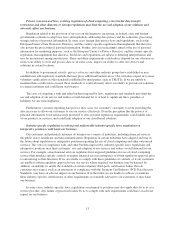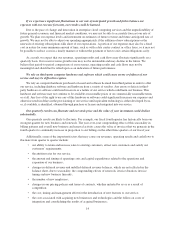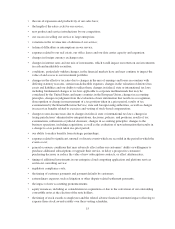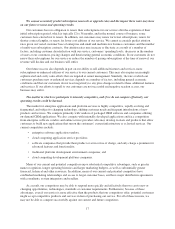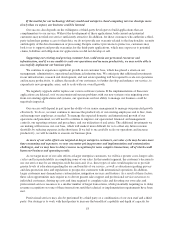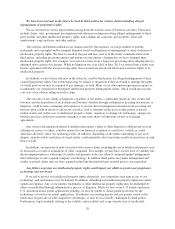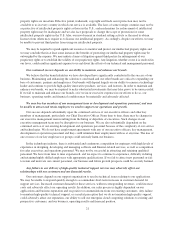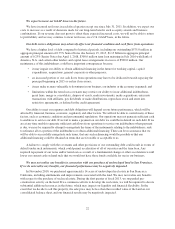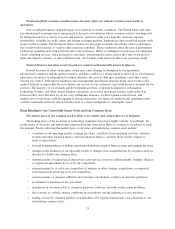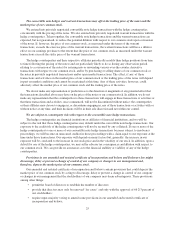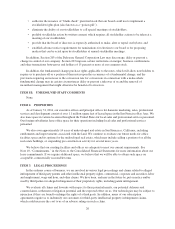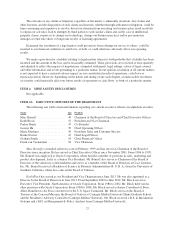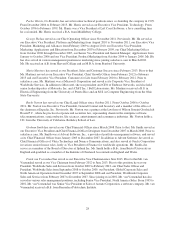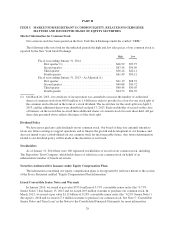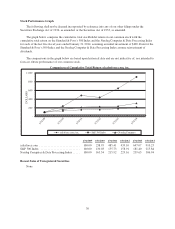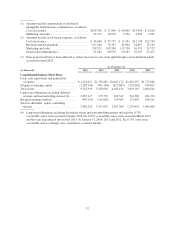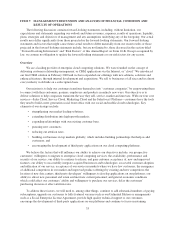Salesforce.com 2014 Annual Report Download - page 27
Download and view the complete annual report
Please find page 27 of the 2014 Salesforce.com annual report below. You can navigate through the pages in the report by either clicking on the pages listed below, or by using the keyword search tool below to find specific information within the annual report.Weakened global economic conditions may adversely affect our industry, business and results of
operations.
Our overall performance depends in part on worldwide economic conditions. The United States and other
key international economies have experienced in the past a downturn in which economic activity was impacted
by falling demand for a variety of goods and services, restricted credit, poor liquidity, reduced corporate
profitability, volatility in credit, equity and foreign exchange markets, bankruptcies and overall uncertainty with
respect to the economy. The European Union continues to face great economic uncertainty which could impact
the overall world economy or various other regional economies. These conditions affect the rate of information
technology spending and could adversely affect our customers’ ability or willingness to purchase our enterprise
cloud computing services, delay prospective customers’ purchasing decisions, reduce the value or duration of
their subscription contracts, or affect attrition rates, all of which could adversely affect our operating results.
Natural disasters and other events beyond our control could materially adversely affect us.
Natural disasters or other catastrophic events may cause damage or disruption to our operations,
international commerce and the global economy, and thus could have a strong negative effect on us. Our business
operations are subject to interruption by natural disasters, fire, power shortages, pandemics and other events
beyond our control. Although we maintain crisis management and disaster response plans, such events could
make it difficult or impossible for us to deliver our services to our customers, and could decrease demand for our
services. The majority of our research and development activities, corporate headquarters, information
technology systems, and other critical business operations, are located near major seismic faults in the San
Francisco Bay Area. Because we do not carry earthquake insurance for direct quake-related losses, and
significant recovery time could be required to resume operations, our financial condition and operating results
could be materially adversely affected in the event of a major earthquake or catastrophic event.
Risks Relating to Our Convertible Senior Notes and Our Common Stock
The market price of our common stock is likely to be volatile and could subject us to litigation.
The trading prices of the securities of technology companies have been highly volatile. Accordingly, the
market price of our notes and underlying common stock has been and is likely to continue to be subject to wide
fluctuations. Factors affecting the market price of our notes and underlying common stock include:
• variations in our operating results, earnings per share, cash flows from operating activities, deferred
revenue and other financial metrics and non-financial metrics, and how those results compare to
analyst expectations;
• forward looking guidance to industry and financial analysts related to future revenue and earnings per share;
• changes in the estimates of our operating results or changes in recommendations by securities analysts
that elect to follow our common stock;
• announcements of technological innovations, new services or service enhancements, strategic alliances
or significant agreements by us or by our competitors;
• announcements by us or by our competitors of mergers or other strategic acquisitions, or rumors of
such transactions involving us or our competitors;
• announcements of customer additions and customer cancellations or delays in customer purchases;
• recruitment or departure of key personnel;
• disruptions in our service due to computer hardware, software, network or data center problems;
• the economy as a whole, market conditions in our industry and the industries of our customers;
• trading activity by a limited number of stockholders who together beneficially own a majority of our
outstanding common stock;
23


